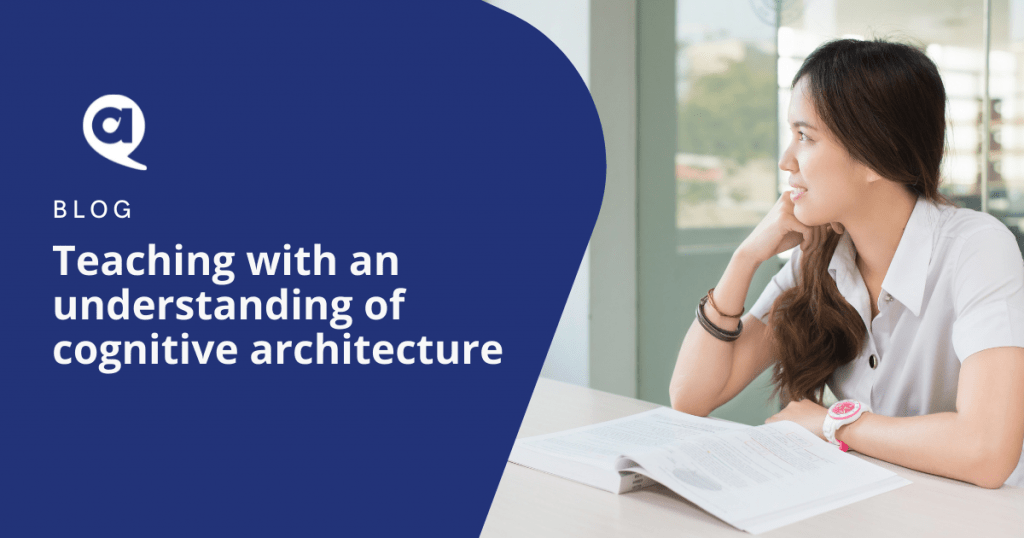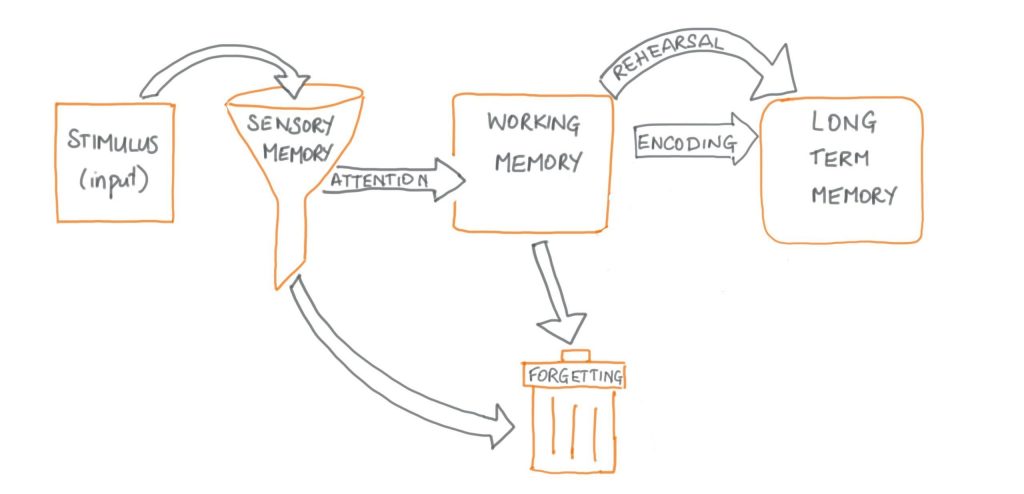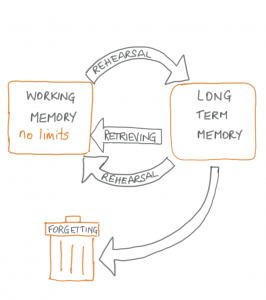
27 January 2022
by Hayley Dean
In education, we talk about learning and what it looks like every day. But what does ‘learning’ actually mean, and how can we use this understanding to guide our teaching practices? Here we look at evidence-based teaching and assessment strategies to maximise learning.
What does the research tell us about how we learn?
Learning occurs when information is successfully transferred from working memory to long-term memory. Without this transfer, nothing has been learned.
Our cognitive architecture refers to how cognitive structures are organised. This includes the sensory memory, the working memory (previously known as the short-term memory), long-term memory and how knowledge is stored in the long-term memory via schemas. It is this organisation that enables learning.

The sensory memory interacts with the incoming stimuli and decides what is important enough to dedicate attention to. The working memory is responsible for receiving and processing information and solving problems. Its capacity is limited with estimates that no more than four units or ‘chunks of information’ can be actively processed simultaneously. In addition, the working memory is able to deal with “information for no more than a few seconds and almost all information is lost after about 20 seconds unless it is refreshed by rehearsal”.
What does this look like in practice?
A student is learning about the principles of training for the first time. The student is trying to learn with a noisy classroom next door and construction work taking place outside the window. Motivated by the student’s respect for the teacher and her desire to do well in the course, the sensory memory filters out information unrelated to learning about the principles of training (e.g. auditory-noisy classroom and visual-construction work). When learning about the principles of training in Core 2, a student must know about the types of training and training methods to be able to understand how the principles of training can be applied.
We know the working memory can only handle about four chunks of information at a time, and it only last for up to about 20 seconds before it is forgotten. This is where elaborative rehearsal strategies, attaching meaning to the concept and content comes into place. After learning about each principle, the student could use the mnemonic SPORTVW (specificity, progressive overload, reversibility, training thresholds, variety and warm-up and cool-down) and apply this concept to athlete case studies using resistance and aerobic training types.
The opportunity for teaching lies in the finding that working memory has no known limitations when using information retrieved from the long-term memory. So what does this mean for teaching, and in particular, what does this look like in a Stage 6 classroom when the intermediate goal is the HSC? This means that our teaching should focus on strategies that support the processes of encoding newly learned information, transferring information and retrieving information.

After encoding the principles of training into the long-term memory using the mnemonic, the student is asked to ‘explain how the principles of training can be applied to a sample resistance training program’. To do this, the encoded information about the types of training and training methods, and the principles of training must be retrieved from the long-term memory for the student to form a response.
By structuring your learning sequences to promote encoding of new information followed by rehearsal activities requiring retrieval of that information students will in time, become more efficient at retrieving information learnt.
Elaborative rehearsal strategies can support memory to maximise learning in PDHPE. This type of rehearsal is effective for transferring information into long-term memory. It involves thinking about the meaning of the information and connecting it to other information already stored in the memory. For example, when students are learning about the principles of training, links can be made to the types of training and training methods through retrieval strategies and this will support the encoding and storage of information about the principles of training in the long-term memory, supporting future retrieval for assessment. A diverse range of examples of rehearsal strategies are provided in the table that follows.
According to Craik & Lockhart (1972) this type of rehearsal works because of the depth of processing required. An effective way to promote elaborative rehearsal is to engage with the information in more than one way. These strategies will include both teaching and assessment strategies, incorporating self-assessment, peer-assessment and teacher assessment.
Resource download – demonstrates how each strategy for memory retention or long-term memory gain can be used in Year 11 and 12 PDHPE.
About the author
Hayley Dean is a passionate health and physical educator with experience as Head Teacher Teaching and Learning, Teacher Advisor, Senior Curriculum Officer at the NESA and PDHPE Project Advisor, 7-12 at the NSW Department of Education (DoE). She is currently a Learning, Teaching and Leading Coordinator with NSW DoE. Hayley is a strong advocate for lifelong learning, building collaborative partnerships and evidence-based practice, currently studying a Doctorate of Education at the University of NSW (UNSW), in the area of Cognitive Load and Load Reduction Instruction (LRI).
References and further reading
Baddeley, A., & Longman, D. (1978). The influence of length and frequency of training sessions on the rate of learning to type. Ergonomics, 21, 627-635.
Board of Studies NSW. (2009). Personal Development, Health and Physical Education Stage 6 Syllabus.
Cowan, N. (2010). The magical mystery four: How is working memory capacity limited, and why? Current Directions in Psychological Science, 19(1), 51-57. http://doi.org/10.1177/0963721409359277
Craik, F.I.M., & Lockhart, R.S. (1972). Levels of processing: A Framework for memory research. Journal of Verbal Learning and Verbal Behaviour, 11(6), 671.
Farrand, P., Hussain, F., & Hennessy, E. (2002). The efficacy of the “mind map” study technique. Medical Education, 36, 426-431.
Hattie, J. (2009). Visible learning; a synthesis of over 800 meta-analyses relating to achievement. Routledge:NY. NY.
Johnson, R., Ginsberg, S & Wilks-Smith, N. (2020). Enhancing memory for learning: Teachers’ journeys of implementing memory strategies in their classrooms, Scan 39(1).
Kirschner, P.A., Sweller, J. & Clark, R.E. (2006). Why minimal guidance during instruction does not work: An analysis of the failure of constructivist, discovery, problem-based, experiential, and inquiry-based teaching. Educational Psychologist, 41, 75-86.
Landauer, T., & Bjork, R. (1978). Optimum rehearsal patterns and name learning. In M. Grneberg, P.Morris & R. Sykes (Eds.), Practical aspects of memory, 625-632. London: Academic Press.
Mayer, R.E., & Morreno, R. (2010). Techniques that reduce extraneous cognitive load and manage intrinsic cognitive load during multimedia learning. In J. L. Plass, R. Moreno, & R. Brunken (Eds.), Cognitive load theory (pp.131-152). Cambridge: Cambridge University Press.
Merrienboer, J.J., & Sweller, J. (2010). Cognitive Load theory in health professional education: design principles and strategies, 85-93. https://doi.org/10.1111/j.1365-2923.2009.03498.x
Palinscar, A.S (2013). Reciprocal Teaching. In J. Hattie & E.M. Anderson (Eds.), International Guide to Achievement (pp.369-371), Taylor and Francis.
Pashler, H., Rohrer, D., Cepeda, N., & Carpenter, S. (2007). Enhancing learning and retarding forgetting: Choices and consequences. Psychonomic Bulletin and Review, 14, 187-193.
RMIT University. (2019). Sans Forgetica wins prestigious design award. https://www.rmit.edu.au/news/all-news/2019/jul/sans-forgetica-award
Schacter, D. (1992). Priming and multiple memory systems: Perceptual mechanisms of implicit memory. Journal of Cognitive Neuroscience, 4, 244-256.
Sweller, J. (2012). Human cognitive architecture: Why some instructional procedures work and others do not. In K. Harris, S. Graham & T. Urdan (Eds.), APA Educational Psychology Handbook. American Psychological Association. Washington.
Sweller, J. (2002). Visualisation and Instructional Design. https://pdfs.semanticscholar.org/d041/c7df26d2d212a6e37204f8615119aff56eed.pdf?_ga=2.6319218.1365109857.1586994562-350032250.1586994562
Wang, A., & Thomas, M. (2000). Looking for long-term mnemonic effects on serial recall: The Legacy of Simonides. American Journal of Psychology, 113, 331-340.
Whitaker, L. (2019). What are some elaborate rehearsal strategies that will transfer learning into long-term memory? https://meteoreducation.com/long-term-memory-2/
How to cite this article – Dean, H. (2020, May). Teaching with an understanding of cognitive architecture. Rethinking Teaching for Learning Article Series (1). (https://achperold.com/teaching-with-an-understanding-of-cognitive-architecture/)


